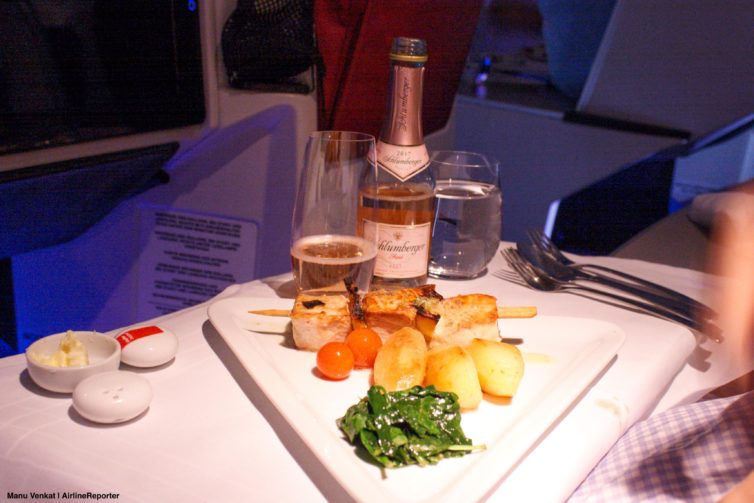
Even at ground level cooking a fancy meal can be tricky. That’s why I’m so amazed by the delicious meals I’ve had while speeding at 600 miles per hour miles in the sky in a narrow metal tube. The fact that airlines can make restaurant-quality meals happen under those constraints — at least in premium cabins — is pretty awesome.
Probably the best food I’ve had in the skies was aboard Turkish Airlines, which relies on an Austria-based company named DO&CO to deliver its “gourmet entertainment” in the skies. So of course Austrian Airlines, which also uses DO&CO for premium cabin catering, has been high on my list ever since. I finally got the chance to fly ’em and try ’em. What did I think? Read on to find out!
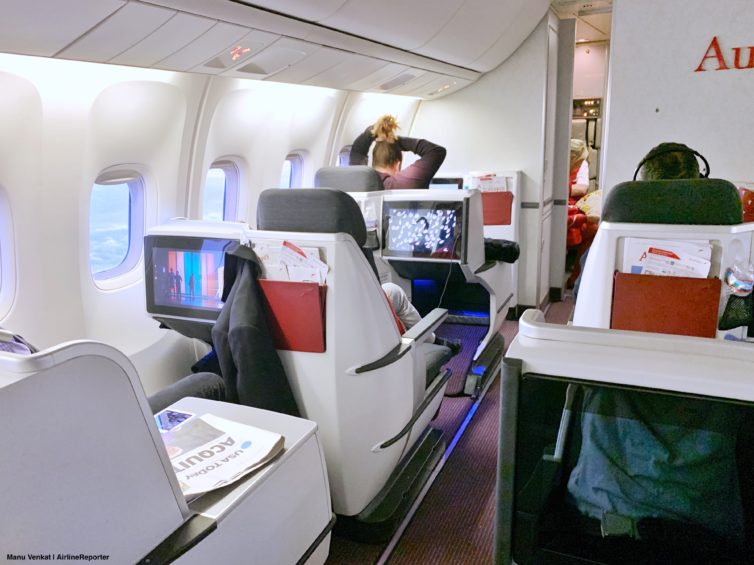
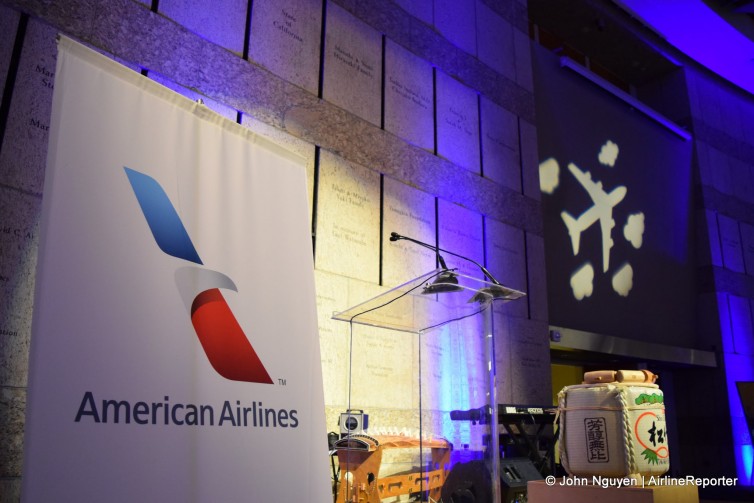
American Airlines hosts a launch party for its new LAX-Haneda flight.
It’s already been a busy 2016 for American Airlines, which has announced several service enhancements and, on February 11, launched its inaugural service from Los Angeles International Airport (LAX) to Toyko International Airport, more commonly known as Haneda Airport (HND). Premium passengers will enjoy additional comfort and convenience both before the flight and onboard, while those in economy will be able to enjoy some of the little things they’ve missed in the past couple of years.
As for American’s new flight into HND, a launch party for VIPs was held the previous night at the Japanese American National Museum in Downtown Los Angeles’ Little Tokyo, and AirlineReporter was invited to the festivities.
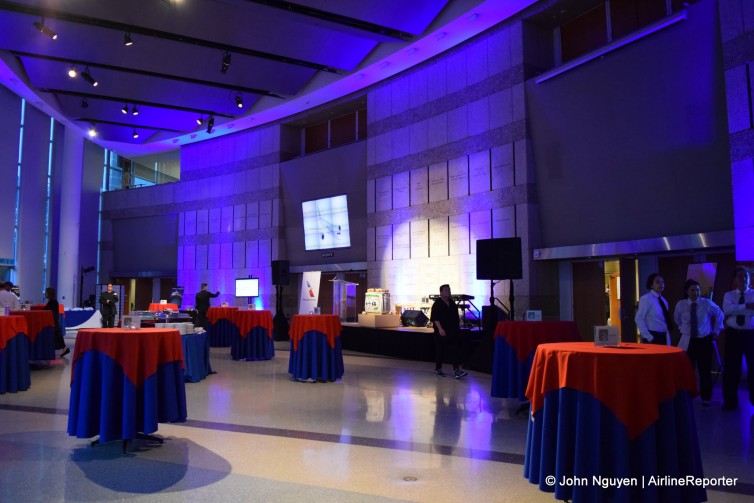
The George & Sakaye Aratani Central Hall at the Japanese American National Museum
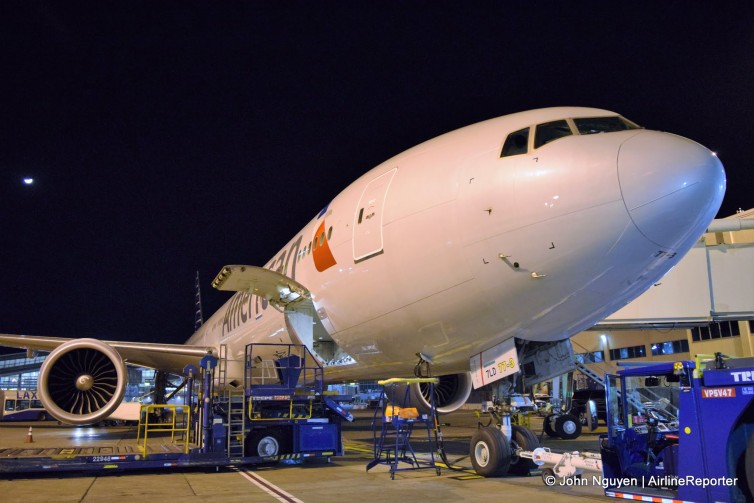
Ground crews at LAX prep an American 777-300ER for its flight to SYD
Previously, I discussed the process and reasoning for using miles for an economy ticket on an American Airlines Boeing 777-300ER from Los Angeles to Sydney. In this story, I am going to share the actual flight experience, and discuss if this was the right call… or a huge mistake.
FLYING AMERICAN DOWN UNDER: Before the Flight
American Airlines Flight 73
Los Angeles International Airport (LAX) to Sydney Airport (SYD)
Equipment: Boeing 777-323ER
Scheduled Departure Time: 9:50pm (actual 10:21pm)
Scheduled Arrival Time: 7:55am+2 (actual 7:31am+2)
Scheduled Flight Time: 15 hours, 5 minutes (actual 14 hours, 9 minutes)
The day came, and we headed out to dinner before going to LAX to catch our evening flight. While taking our dinner at a leisurely pace, I checked on our flight status and realized that I had confused the departure time as being 10:50pm instead of 9:50pm; fortunately I caught my mistake with enough time to rush through our meal and still make it to the airport comfortably.
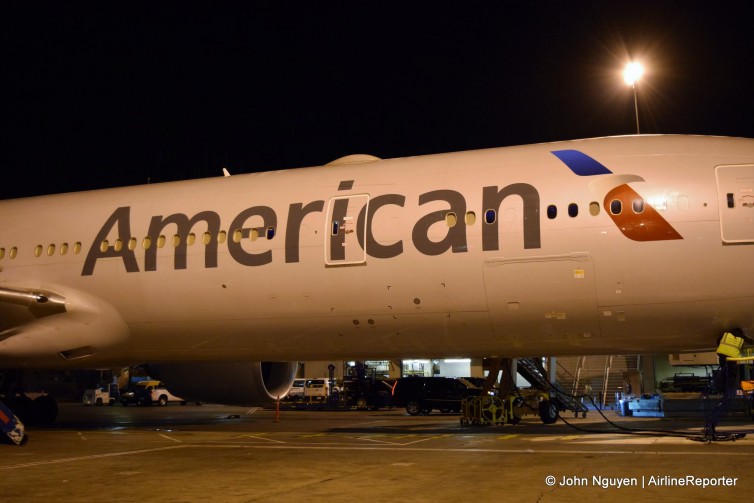
An American Airlines 777-300ER (N720AN) bound for SYD on the inaugural flight pushes back from Gate 41 at LAX.
Less than a week after covering American Airlines’ launch of their new Los Angeles-Sydney service, I found myself onboard Flight 73 on a last-minute holiday down under. The route featured American’s flagship Boeing 777-300ER, with my personal-favorite business class seat. In spite of holding status on both American and Alaska, which would entitle me to at least a little bit more leg and elbow room in coach, I willingly (!) chose to sit in a regular economy seat for a 15-hour flight… and managed to survive. A feat made even more impressive (or harrowing, depending on your point-of-view) by the fact that I was accompanied by my wife.
Now, I’d like to claim credit for taking one for the AirlineReporter team and be able to gloat for making the trip, but I’m not as magnanimous as my colleague JL, who flew a Spirit Airlines Bare Fare “for science.” There were very strategic, practical, and self-serving reasons for booking seats behind the curtain instead of in front of it.
I’m splitting my experience into two parts: first, about why I chose economy (this time), followed up with my actual flight review of American’s economy service to Sydney.
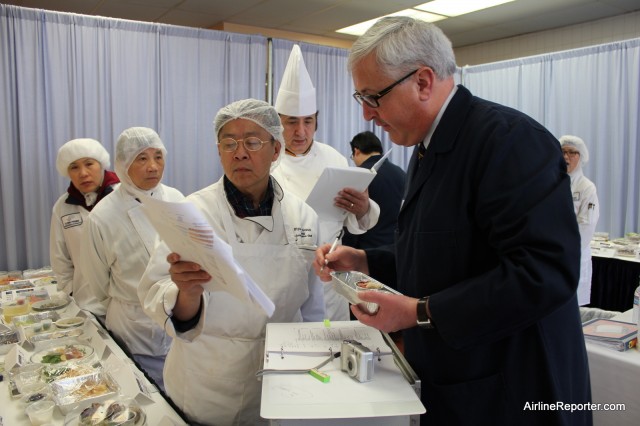
Singapore Airlines goes item by item checking the food quality at the Flying Food Group at SFO.
When it comes to airline food, most people have a pretty low expectation of what they will receive. That expectation has lowered even further over the past few years with the almost-complete elimination of free airline food served on domestic flights within the United States. To find a decent airline meal, one needs to take an international flight. Typically, the amount you pay for a ticket will correlate with the level of meal you will receive. How does a world class airline go about providing multiple meals for up to 477 passengers on just one flight? I wasn’t sure, but when I was recently given the opportunity to check out how Singapore Airlines runs its food operation out of San Francisco (SFO), I could not refuse (note that my trip down and back were taken care of by Singapore Airlines and JetSuite).
Checking out Singapore Airlines makes sense. For them, food is not just something they give to passengers to make sure they don’t go hungry; they see it as part of the in-flight service. It is an experience both via taste/sight and a positive interaction with the flight crew. How does an airline prepare a meal for someone who has spent $5000.00 or even $20,000.00 on a ticket and are used to the best things in life? Well, it is not easy, nor cheap. Each year, Singapore Airlines spends about $500,000,000.00 just on their food service alone — that is quite the investment.
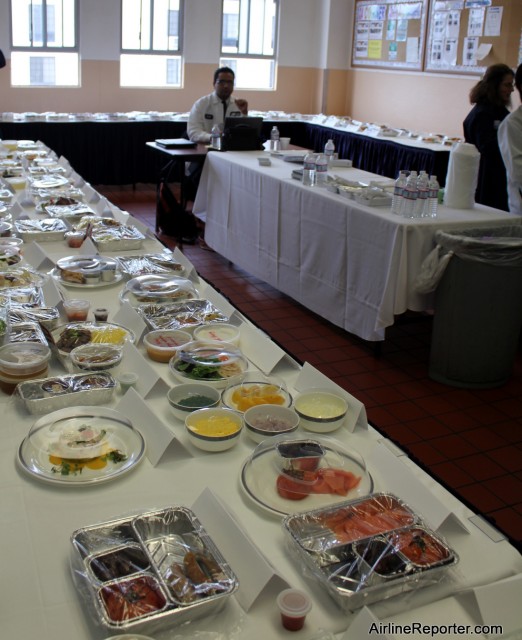
The room has food all around from first, business and economy levels of service.
At each main Singapore Airlines hub in the US, it selects a caterer to produce the food. At SFO, it uses Flying Food Group, which also provides airline catering for a number of other airlines, even though all of Singapore’s recipes are unique.
Frequent fliers on Singapore do not want to see the same food week after week, so the airline needs to keep the selection new. Because of this, Singapore Airlines changes most of its entire menu each quarter. Hidden away in Singapore Airlines headquarters is a list of all the food that will be served in the coming quarters. The menu is not just a broad, “we will serve chicken and salad,” but a list that is extremely detailed, down to the exact last gram of everything, how many nuts will be on that salad and how much the entire meal will weigh.
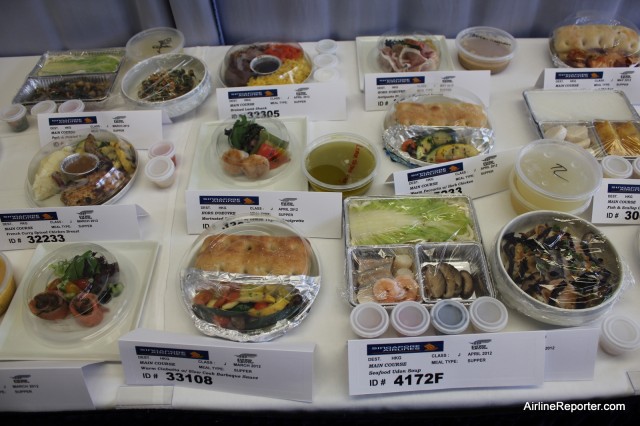
The Singapore food tasters need to come in hungry, since they will be leaving full.
There is no down time when it comes to the food. Just after the previous quarter’s food goes live, Singapore sends the next quarter’s menu to the Flying Food Group, so that they can start preparations for following quarter. Their chefs work on successfully creating the new menu and once they have all the food from each of the three classes completed, they invite Singapore Airlines in for a Menu Presentation to visually inspect each and every item and then taste test the food — this is where my visit comes in.
After landing at SFO, I was driven to the Flying Food Group building, located just down the street from the airport. The building is not the most beautiful on the outside, but it is more about what is on the inside. After being checked in, I put on an official food tester garb and was taken to a back room, which had hundreds of different food options on display. Representatives from both the Flying Air Group and Singapore Airlines went item by item, going over every aspect of each main dish, side dish, sauces and the plate layout.
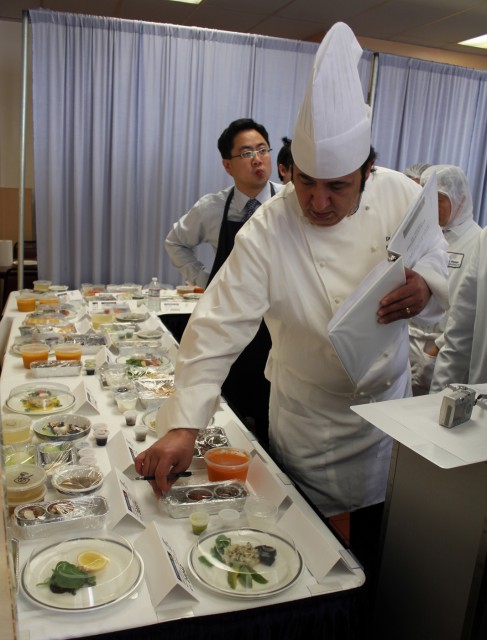
The chef shows off his creations.
Once the food is agreed upon, photos are taken that will be placed on the aircraft, so that flight attendants will know what the final serving should look like. But before anything can be finalized, the food needs to be tasted. It is a rough life, but to be able to write the best story possible, I decided I should probably try some of the food.
We were escorted to another room, where samples of the food were being served. From the soups to salads, to main entrees, I have to say that they were good — really good. During the sampling it was determined that one of the soups was a bit too spicy and Singapore requested that it be toned down a bit and the caterer agreed.
Making quality food at a restaurant on the ground is difficult enough as it is. Creating a meal, that will not be eaten for another ten hours and it still needs to taste world class is a whole other level. One question is how much should the caterer cook the food vs how much does it get cooked on the plane? For example, chicken will be cooked about 60% on the ground and the rest in the air, where steak will only be cooked 30% before being loaded onto a plane.
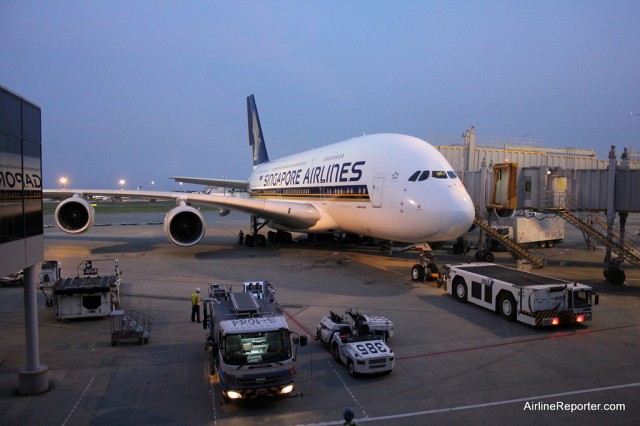
Singapore Airlines Airbus A380 can hold 471 people. Times that by multiple meals and things can get challenging. This A380 is seen waiting at Narita in Tokyo.
No matter what level the food is cooked, once it is ready, it is “blast chilled.” Now, do not call this “freezing” the food — I got the feeling that calling it that is borderline insulting. In the blast-chilled process, the food is taken to just above freezing very quickly, but doesn’t cause all the damage at the cellular level that freezing does. The food is then loaded onto carts, then to a truck, then off to the airport to be loaded onto the aircraft. It is an impressive ballet of trying to time things just right so the food does not go too long before being consumed.
Delays in the airline business are inevitable. While passengers begin to stress about arriving late, there are people who are thinking about the food. If a delay pops up early enough, the food’s preparation is held off until later. If the food is already made, it will be stored in a freezer at the caterer. The worse case scenario, if a flight is delayed after the food has already been loaded onto the aircraft, there are times, where the call is made to dump the current food and have the caterer bring over a fresh supply. It is a costly waste, but better than passengers getting sub-par food or worse, sick.
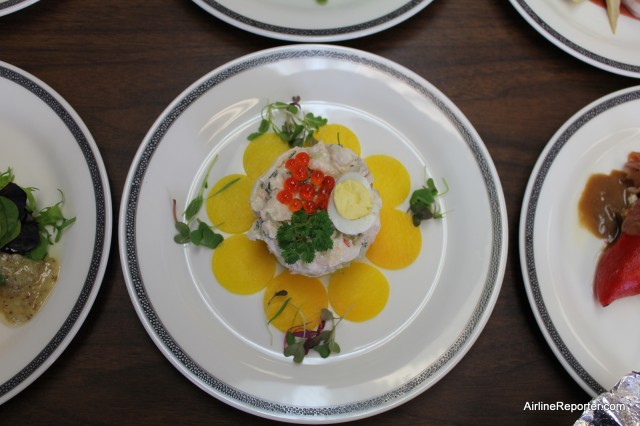
Lobster, quail eggs and caviar make for an impressive meal.
It is difficult, but having to destroy food is part of the airline catering business. At the end of each flight, there will always be left over food. Either from passengers who didn’t finish their entire meal or for whole carts of food that were never used. Due to international regulations, all food that returns to the US on an international flight needs to be destroyed. The carts are loaded back onto the caterer’s trucks, taken to the facility and placed into a huge oven before being disposed of. This is to assure that there are no food-borne bugs that could cause an international incident.
Serving the same quality of food in economy as you do in first class could also cause some sort of incident — folks who pay more, expect a higher level of food. First class meals are prepared using three different types of ovens: steam, convection and microwave. Each item is individually cooked before being served to the customer. Economy food is made to be more efficient and less time consuming. If you order scramble eggs as a First Class passenger, they will break open real eggs while in-flight and prepare them right there on the plane for you. However, if you are seated more towards the back, you are getting pre-prepared eggs from the ground.
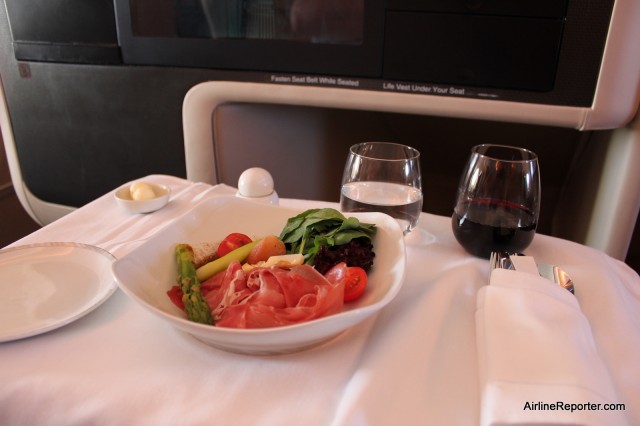
And then, the meal ends up on the plane. This photo is from 2010 on Singapore Airlines A380 Business Class.
What amazed me the most about this was how much process, time, energy and money is involved to get food to passengers. The crazy thing is this is only for SFO flights, (there are only three: Seoul, Hong Kong and Singapore) and each of these steps are repeated around the world.
If you get bored of the Singapore menu before the quarter runs out, you also have the options Book the Cook program, which allows you to order a custom meal.
I have had the opportunity to fly on Singapore Airlines A380 previously, and I had no idea the work and preparation that went into my food. Airline food might never be the same for me. I am always going to think about how the meal was planned, cooked and the detailed process it experienced before reaching my palate.
View all 23 photos from the Singapore Menu Presentation












